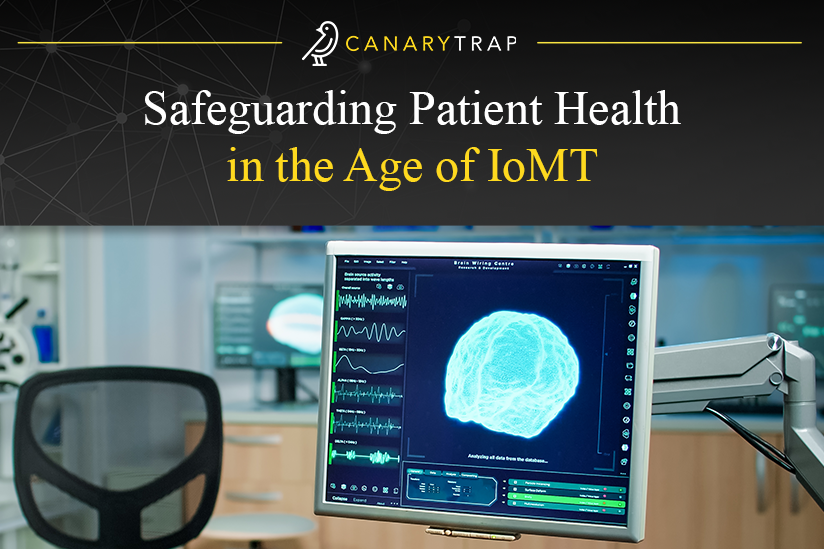Safeguarding Patient Health in the Age of IoMT
- April 5, 2024
- Canary Trap
The advent of the Internet of Things (IoT) has ushered in a new era of connectivity and convenience across various industries, including healthcare. Within this landscape, the Internet of Medical Things (IoMT) has emerged as a revolutionary force, promising to enhance patient care, streamline medical processes, and improve overall healthcare outcomes. IoMT devices encompass a wide range of interconnected medical devices and applications, from wearable health trackers to remote monitoring systems and implantable sensors.
While the proliferation of IoMT devices offers unprecedented opportunities for innovation and efficiency in healthcare delivery, it also introduces significant cybersecurity challenges. As these devices become increasingly interconnected and integrated into clinical workflows, they become potential targets for malicious actors seeking to exploit vulnerabilities for nefarious purposes. The consequences of cybersecurity breaches in the IoMT ecosystem can range from compromised patient data to disruptions in medical services and even threats to patient safety.
In this blog, we will delve into the intricate intersection of cybersecurity and the Internet of Medical Things, exploring the importance of securing IoMT devices, the inherent risks they pose, and the regulatory landscape governing their use. Additionally, we will also discuss best practices for mitigating cybersecurity threats in IoMT environments and highlight the critical role of cybersecurity in safeguarding patient privacy and healthcare infrastructure.
The Importance of IoMT Devices
The Internet of Medical Things (IoMT) devices play a pivotal role in revolutionizing healthcare delivery by offering unprecedented capabilities to monitor, diagnose, and treat patients remotely. These devices encompass a diverse array of interconnected technologies, including wearable sensors, implantable devices, remote monitoring systems, and smart medical appliances.
The importance of IoMT devices lies in their ability to enhance patient care, improve clinical outcomes, and optimize healthcare processes in various ways. First and foremost, IoMT devices enable remote patient monitoring, allowing healthcare providers to track vital signs, medication adherence, and disease progression outside traditional clinical settings. This capability is particularly valuable for patients with chronic conditions or those requiring continuous monitoring, as it enables early detection of health issues, timely interventions, and personalized treatment plans.
An article by Relevant Software adds that “for the general public, wearable devices like fitness trackers provide insights into essential health metrics. More than just monitoring, some of these devices, such as the Apple Watch, can detect potential health threats, acting as a first line of defense. For more specialized care, clinical on-body IoMT devices offer an expanded range of monitoring options. A prime example would be the glucose sensors for diabetic patients, which can immediately notify them of glucose level anomalies.”
By empowering patients to take an active role in managing their health and enabling proactive interventions, IoMT devices contribute to improved patient outcomes and quality of life. Moreover, IoMT devices facilitate real-time data collection and analysis, providing healthcare professionals with valuable insights into patient health status and treatment efficacy. This data-driven approach enables personalized medicine, whereby treatment decisions are tailored to individual patient characteristics, preferences, and responses.
Furthermore, IoMT devices enhance operational efficiency and resource utilization within healthcare organizations. By automating routine tasks, and facilitating remote consultations, these devices optimize clinical workflows, reduce administrative burdens, and enhance healthcare delivery capacity, which translates to cost savings and improved healthcare service quality.
Cybersecurity Risks in IoMT
While the Internet of Medical Things (IoMT) holds immense promise for transforming healthcare delivery, it also introduces a host of cybersecurity risks that can compromise patient safety, privacy, and data integrity. As IoMT devices become increasingly interconnected and integrated into clinical workflows, they become lucrative targets for cyberattacks, posing significant challenges for healthcare organizations and providers.
As it was shrewdly explained in Today’s Medical Developments, “the cybersecurity of devices within the internet of medical things (IoMT) is particularly important for several reasons. The most obvious reason is that many medical devices are life-sustaining devices. A failed or unavailable device could lead to painful and damaging patient outcomes, including death. The second reason is that the nature of the attack surface in the IoMT is unusual. The attack surface area is growing rapidly, and it is also a highly mobile attack surface for which physical security is impossible. Unlike, say, an industrial IoT application or smart city IoT application, a medical device in the IoMT can be anywhere in the world, and for wearable and embedded devices, a device may be wherever the patient is.”
These examples highlight the importance of understanding and mitigating cybersecurity risks in order to safeguard patient health information and ensure the reliability and security of IoMT deployments. Some of the most common risks in IoMT include:
- Vulnerabilities in Device Firmware and Software
IoMT devices often run on embedded systems with outdated firmware and software, making them susceptible to exploitation by cybercriminals. These vulnerabilities can enable unauthorized access, data breaches, and device manipulation, compromising patient safety and data integrity.
- Inadequate Authentication and Access Controls
Weak authentication mechanisms and lax access controls make IoMT devices vulnerable to unauthorized access and tampering. Without robust authentication measures, malicious actors can compromise device integrity, intercept sensitive data, and disrupt critical healthcare operations.
- Data Privacy and Confidentiality Concerns
The interconnected nature of IoMT devices increases the risk of unauthorized data access, disclosure, and theft. Patient health information stored or transmitted by these devices is often targeted by cybercriminals for financial gain or malicious intent, posing significant privacy and confidentiality risks.
- Lack of Security Standards and Regulatory Oversight
The absence of uniform security standards and regulatory oversight for IoMT devices leaves them vulnerable to exploitation and manipulation. Without stringent security requirements and compliance frameworks, manufacturers may prioritize functionality over security, exposing patients and healthcare organizations to increased cybersecurity risks.
- Integration Challenges and Interoperability Issues
The integration of diverse IoMT devices with existing healthcare systems and networks poses challenges for ensuring seamless interoperability and security. Incompatibilities between devices, protocols, and standards can create vulnerabilities and weak points in the healthcare infrastructure, facilitating cyberattacks and data breaches.
The proliferation of IoMT devices introduces significant cybersecurity risks that must be addressed to ensure the safety, privacy, and integrity of patient health information. Healthcare organizations and providers must adopt a proactive approach to cybersecurity, implementing robust security measures, protocols, and training programs to mitigate threats and safeguard IoMT deployments.
Regulatory Framework
As the Internet of Medical Things (IoMT) continues to revolutionize healthcare delivery, regulatory bodies and policymakers are faced with the challenge of developing and implementing comprehensive regulatory frameworks to ensure the safety, efficacy, and security of IoMT devices and systems. A robust regulatory framework is essential to address the unique cybersecurity risks associated with IoMT and to promote patient safety, privacy, and data integrity. Let’s explore the evolving regulatory landscape governing IoMT and the key initiatives aimed at enhancing cybersecurity in healthcare:
- Regulatory Landscape for IoMT Devices
The regulatory landscape for IoMT devices is multifaceted, encompassing a diverse array of regulations, standards, and guidelines established by regulatory agencies and international organizations. In the United States, the Food and Drug Administration (FDA) plays a central role in regulating medical devices, including IoMT devices, to ensure their safety and effectiveness. The FDA’s premarket review process evaluates the cybersecurity risks associated with IoMT devices and requires manufacturers to implement appropriate security controls and risk mitigation strategies.
Shankar Somasundaram, CEO at Asimily, explains that “Government requirements enforcing baseline security on medical devices have only recently arrived. The 2023 PATCH Act requires manufacturers to meet criteria for the cybersecurity and transparency of their products and to support them with security patches across their full life cycles.” He also maintains that “the U.S. Cyber Trust Mark program scheduled for implementation at the end of 2024 will establish security standards for consumer-grade devices and may expand to healthcare-grade IoMT products.”
Regulatory bodies such as the Department of Health and Human Services (HHS) and the Office for Civil Rights (OCR) also enforce regulations such as the Health Insurance Portability and Accountability Act (HIPAA), which governs the privacy and security of protected health information (PHI). HIPAA’s Security Rule requires covered entities and business associates to implement safeguards to protect PHI, including IoMT data, from unauthorized access, disclosure, and alteration.
Additionally, organizations such as the International Medical Device Regulators Forum (IMDRF) and the International Organization for Standardization (ISO) develop standards and guidelines for IoMT cybersecurity to harmonize regulatory requirements and promote global interoperability. These initiatives aim to establish consensus-based cybersecurity principles, best practices, and technical standards to guide manufacturers, healthcare providers, and regulatory agencies in addressing cybersecurity risks in IoMT.
Best Practices for Securing IoMT Devices
Implementing robust cybersecurity measures is essential for safeguarding the integrity and security of IoMT devices and systems. By adopting the following best practices, healthcare organizations can mitigate the risk of cyber threats:
- Strong Authentication Protocols
Implement multi-factor authentication (MFA) and biometric authentication methods to ensure that only authorized personnel can access IoMT devices and systems.
- Security Updates and Patch Management
Stay proactive in applying security updates and patches to IoMT devices and systems. Regularly update firmware and software to address known vulnerabilities and mitigate the risk of exploitation by cyber attackers.
- Network Segmentation and Access Controls
Implement network segmentation to isolate critical healthcare systems and IoMT devices from unauthorized access. Restricting access to IoMT networks helps minimize the impact of potential security incidents and enhances overall cybersecurity resilience.
According to an article published by Workers Compensation, “maintaining the health of medical devices and safeguarding personal information is not solely the responsibility of device manufacturers and healthcare providers. Patients and caregivers also have a vital role to play in this regard.” To that effect, it was also mentioned that the FDA provides tips for patients and caregivers, including: adopting good password practices, maintaining physical control over the IoMT device, and conducting regular updates to ensure optimal protection.
Adopting best practices for securing IoMT devices is crucial for protecting patient data, maintaining the integrity of healthcare services, and mitigating the risk of cyber threats. By implementing strong authentication protocols, regularly updating security patches, and implementing network segmentation, healthcare organizations can enhance the security posture of their IoMT ecosystems and ensure the confidentiality and integrity of patient information.
In Conclusion
As the Internet of Medical Things (IoMT) continues to transform healthcare delivery, cybersecurity remains a critical concern for healthcare organizations worldwide. The convergence of medical devices, data analytics, and interconnected networks presents unprecedented opportunities for improving patient care and clinical outcomes, but also introduces new vulnerabilities and cybersecurity risks.
Effective cybersecurity in the IoMT landscape requires a multi-faceted approach, encompassing technical solutions, organizational policies, regulatory compliance, and ongoing education and training. In an era of rapid technological innovation and digital transformation, prioritizing cybersecurity resilience is paramount to safeguarding the future of healthcare. By embracing best practices and staying vigilant in the face of evolving cyber threats, healthcare organizations can harness the full potential of IoMT while ensuring the confidentiality, integrity, and availability of healthcare services for patients worldwide.
SOURCES:
- https://relevant.software/blog/what-is-iomt/#:~:text=Wearable%20medical%20devices%2C%20which%20are,insights%20into%20essential%20health%20metrics.
- https://www.todaysmedicaldevelopments.com/news/addressing-cybersecurity-risks-medical-devices-automated-testing-iot/
- https://www.healthcareittoday.com/2024/01/08/heres-what-to-expect-from-iomt-cybersecurity-in-2024/
- https://www.workerscompensation.com/expert-analysis/internet-connected-medical-devices-and-cybersecurity-risk/

